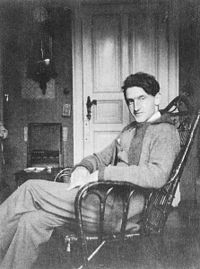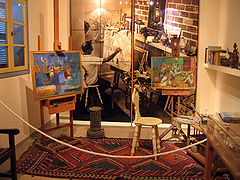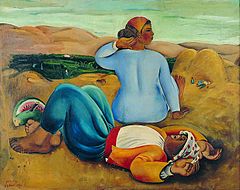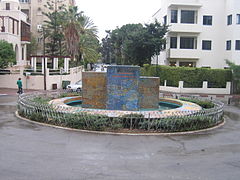- Nachum Gutman
-
Nachum Gutman 
Nachum Gutman in Vienna, 1920Born October 5, 1898
Teleneşti , BessarabiaDied November 28, 1980 (aged 82) Nationality Israeli, Jewish Field Painting Training Bezalel Academy of Arts and Design Awards Dizengoff Prize, Lamdan Prize, Israel Prize Nachum Gutman (alternate romanization: Nahum Gutman; Hebrew: נחום גוטמן: born October 5, 1898, died November 28, 1980) was a Russian-born Israeli painter, sculptor, and author.
Contents
Early life
Gutman was born in Teleneşti, Bessarabia, Romania, then a part of the Russian Empire. He was the fourth child of Alter and Rivka Gutman. His father was a Hebrew writer and educator who wrote under the pen name S. Ben Zion. In 1903, the family moved to Odessa, and two years later, to Ottoman Palestine.
Artistic career
Gutman helped pioneer a distinctively Israeli style, moving away from the European influences of his teachers. He worked in many different media: oils, watercolours, gouache and pen and ink.
His sculptures and brightly colored mosaics can be seen in public places around Tel Aviv. Indoor murals depicting the history of Tel Aviv can be seen in the western wing of the Shalom Tower and the Chief Rabbinate building. A mosaic fountain with scenes from Jewish history stands at the corner of Bialik Street, opposite the old Tel Aviv municipality building.[1]
Returning to Israel in 1927, after a long sojourn in Europe, Gutman undertook the illustration of C.N. Bialik's writings until the poet's death in 1937. His Illustrations of Bialik's "Legends" were the peak of this project, and his style- monumental, sculptural, primitive, influenced by Assyrian sculpture and Persian miniature- perfectly suited Bialik's biblical themes. Gutman was one of the major formulators of Eretz Israel art-starkly simple, earthy and powerful, aggressively asserting its sense of place. The booklet of protest illustrations by Gutman, published immediately after the 1929 riots, was the first manifestation of the dashing of the Eretz Israel myth of Arab-Jewish integration. Gutman, as one of the formulators of the idealization of the Arab in art, was the first to respond to the new identity crisis facing the Eretz Israel Jew. He was to return to the depiction of the East in his later work.
Gutman's artistic style was eclectic, ranging from figurative to abstract. Gutman was also a well-known writer and illustrator of children's books.
Education
- 1908 Herzlia Gymnasium, Tel Aviv
- 1912 Art, Bezalel Academy of Arts and Design, Jerusalem.
- 1920–26 Art, Vienna, Berlin and Paris
Awards and honours
Gutman received many art and literary prizes:[2]
- 1938: Dizengoff Prize for painting (also in 1956)[3]
- 1946: Lamdan Prize for children's literature
- 1955: Sicily Award for watercolor painting at the São Paulo Biennale
- 1956: Dizengoff Prize for painting (also in 1938)[3]
- 1962: Hans Christian Andersen Literary Prize on behalf of Unesco for his book "Path of Orange Peels"
- 1964: Yatziv Prize
- 1969: Fichman Prize for Literature and Art
- 1974: Honorary Doctor of Philosophy from Tel Aviv University
- 1976: Honorary Citizen of Tel Aviv
- 1978: Israel Prize, for children's literature[4]
The Nachum Gutman Museum, showcasing the artist's work, was established in the Neve Tzedek neighborhood of Tel Aviv.[5]
In 2005, he was voted the 110th-greatest Israeli of all time, in a poll by the Israeli news website Ynet to determine whom the general public considered the 200 Greatest Israelis.[6]
Outdoor and public art
- 1961 A mosaic wall in the house of the Chief Rabbinate, Tel Aviv
- 1966 A mosaic wall in "Migdal Shalom", Tel Aviv
- 1967 A mosaic wall for the "Herzliya" high school, Tel Aviv
- 1976 History of Tel Aviv-Jaffa, mosaic, Bialik Square, Tel Aviv
Published works
- Path of the Orange Peels: Adventures in the Early Days of Tel Aviv (English translation: Nelly Segal) Dodd, Mead & Company, 1979
See also
References
- ^ Mosaic Mural – Mosaic Artist – Nachum Gutman – Shalom Tower – Tel Aviv, Israel « Mosaic Art Source
- ^ A Street in Neve Zedek. Artist: Nachum Gutman. Hand Signed & Numbered Limited Edition Serigraph
- ^ a b "List of Dizengoff Prize laureates" (in Hebrew). Tel Aviv Municipality. http://www.tel-aviv.gov.il/Hebrew/_MultimediaServer/Documents/12516742.pdf.
- ^ "Israel Prize Official Site – Recipients in 1978 (in Hebrew)". http://cms.education.gov.il/EducationCMS/Units/PrasIsrael/Tashlag/Tashmab_Tashlag_Rikuz.htm?DictionaryKey=Tashlach.
- ^ Nachum Gutman Museum
- ^ גיא בניוביץ' (June 20, 1995). "הישראלי מספר 1: יצחק רבין – תרבות ובידור". Ynet. http://www.ynet.co.il/articles/0,7340,L-3083171,00.html. Retrieved July 10, 2011.
External links
- The Nachum Gutman Museum (in Hebrew and English)
- Nachum Gutman – Illustrates stories of the Bible Exhibition
- The Mosaics of Nachum Gutman
- Art of Nachum Gutman at Europeana. Retrieved September 2011
- Nachum Gutman collection at the Israel Museum. Retrieved September 2011
- "Nachum Gutman". Information Center for Israeli Art. Israel Museum. http://www.imj.org.il/artcenter/default.asp?artist=272359. Retrieved September 2011.
Categories:- 1898 births
- 1980 deaths
- People from Teleneşti District
- Moldovan Jews
- Bessarabian Jews
- Israeli Jews
- Israeli people of Moldovan origin
- Israeli painters
- Israeli artists
- Jewish painters
- Jewish artists
- Israel Prize in children's literature recipients
- Dizengoff Prize recipients
- Lamdan Prize recipients
- Biographical museums in Israel
Wikimedia Foundation. 2010.



